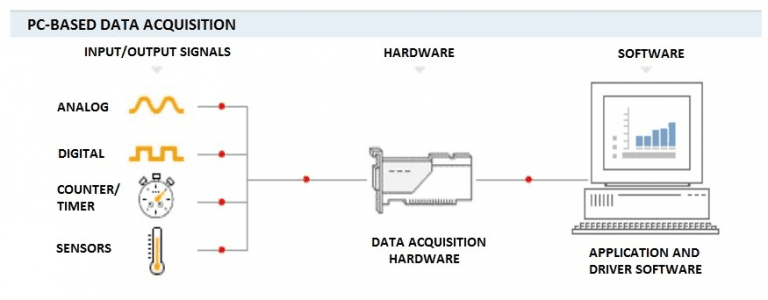- Dataflow Programming and Data Types in LabVIEW
- LabVIEW Interview Questions
- LabVIEW Programming
- LabVIEW Tutorial
- Block Diagram in LabVIEW
- LabVIEW Graphs and Charts
- Initializing Arrays In Labview
- Introduction of Repetition And Loops in LabVIEW
- Local and Global Variables in LabVIEW Tutorial
- Overview Of Clusters In Labview
- Shift Registers in LabVIEW
- Labview Structures
- LabVIEW Projects and Use Cases
- How to install LabVIEW on Windows
Introduction to LabVIEW
LabVIEW (Laboratory Virtual Instrument Engineering Workbench) is a graphical programming environment which has become prevalent throughout research labs, academia, and industry. It is a powerful and versatile analysis and instrumentation software system for measurement and automation. It's graphical programming language called G programming is performed using a graphical block diagram that compiles into machine code and eliminates a lot of the syntactical details.
LabVIEW offers more flexibility than standard laboratory instruments because it is software-based. Using LabVIEW, the user can originate exactly the type of virtual instrument needed and programmers can easily view and modify data or control inputs. The popularity of the National Instruments LabVIEW graphical dataflow software for beginners and experienced programmers in so many different engineering applications and industries can be attributed to the software’s intuitive graphical programming language used for automating measurement and control systems.
If you would like to Enrich your career with an Android certified professional, then visit Mindmajix - A Global online training platform: “LabVIEW training” Course.This course will help you to achieve excellence in this domain.
LabVIEW programs are called virtual instruments (VIs), because their appearance and operation imitate physical instruments like oscilloscopes. LabVIEW is designed to facilitate data collection and analysis, as well as offers numerous display options. With data collection, analysis and display combined in a flexible programming environment, the desktop computer functions as a dedicated measurement device. LabVIEW contains a comprehensive set of VIs and functions for acquiring, analyzing, displaying, and storing data, as well as tools to help you troubleshoot your code.
All test, measurement and control applications can be divided into three main components and the key to virtual instrumentation is the ability to acquire, analyze and present data. LabVIEW can acquire data using the devices like GPIB, Serial, Ethernet, VXI, PXI Instruments, Data Acquisition (DAQ), PCI eXtensions for Instrumentation (PXI), Image Acquisition (IMAQ), Motion Control, Real-Time (RT) PXI, PLC (through OPC Server), PDA, and Modular Instruments.
To help you analyze your data LabVIEW includes analysis functions for Differential Equations, Optimization, Curve Fitting, Calculus, Linear Algebra, Statistics and so on. Express VIs are specifically designed for measurement analysis, including filtering and spectral analysis. Signal Processing VIs for Filtering, Windowing, Transforms, Peak Detection, Harmonic Analysis, and Spectrum Analysis are provided. LabVIEW includes the following tools to help in presenting data on the computer; Graphs, Charts, Tables, Gauges, Meters, Tanks, 3D Controls, Picture Control, 3D Graphs and Report Generation. Over the Internet, Web Publishing Tools, Data socket (Windows Only), TCP/IP, VI Server, Remote Panels and Email are available to present data.
Frequently Asked LabVIEW Interview Questions & Answers
LabVIEW can communicate with hardware such as data acquisition, vision, and motion control devices, and GPIB, PXI, VXI, RS-232, and RS-485 devices. LabVIEW also has built-in features for connecting your application to the Web using the LabVIEW Web Server and software standards such as TCP/IP networking and ActiveX. Using LabVIEW, you can create test and measurement, data acquisitions, instrument control, datalogging, measurement analysis, and report generation applications. You also can create stand-alone executables and shared libraries, like DLLs, because LabVIEW is a true 32-bit compiler.
For new programmers, LabVIEW Express technology transforms common measurement and automation tasks into much higher-level, intuitive VIs. With Express technology, thousands of nonprogrammers have taken advantage of the LabVIEW platform to build automated systems quickly and easily.
For experienced programmers, LabVIEW delivers the performance, flexibility and compatibility of a traditional programming language such as C or BASIC. In fact, the full-featured LabVIEW programming language has the same constructs that traditional languages have such as variables, data types, objects, looping and sequencing structures, as well as error handling. And with LabVIEW, programmers can reuse legacy code packaged as DLLs or shared libraries and integrate with other software using ActiveX, TCP and other standard technologies.
The LabVIEW Family consists of NI LabVIEW Graphical Programming Software for Measurement and Automation, LabVIEW Real-Time Module, LabVIEW FPGA Module, LabVIEW PDA Module, LabVIEW Datalogging and Supervisory Control Module.
Advantages of LabVIEW
The following are the advantages of LabVIEW:
- Graphical user interface: Design professionals use the drag-and-drop user interface library by interactively customizing the hundreds of built-in user objects on the controls palette.
- Drag-and-drop built-in functions: Thousands of built-in functions and IP including analysis and I/O, from the functions palette to create applications easily.
- Modular design and hierarchical design: Run modular LabVIEW VIs by themselves or as subVIs and easily scale and modularize programs depending on the application.
- Multiple high level development tools: Develop faster with application-specific development tools, including the LabVIEW Statechart Module, LabVIEW Control Design and Simulation Module and LabVIEW FPGA Module.
- Professional Development Tools: Manage large, professional applications and tightly integrated project management tools; integrated graphical debugging tools; and standardized source code control integration.
- Multi platforms: The majority of computer systems use the Microsoft Windows operating system. LabVIEW works on other platforms like Mac OS, Sun Solaris and Linux. LabVIEW applications are portable across platforms.
- Reduces cost and preserves investment: A single computer equipped with LabVIEW is used for countless applications and purposes—it is a versatile product. Complete instrumentation libraries can be created for less than the cost of a single traditional, commercial instrument.
- Flexibility and scalability: Engineers and scientists have needs and requirements that can change rapidly. They also need to have maintainable, extensible solutions that can be used for a long time. By creating virtual instruments based on powerful development software such as LabVIEW, you inherently design an open framework that seamlessly integrates software and hardware. This ensures that your applications not only work well today but that you can easily integrate new technologies in the future.
- Connectivity and instrument control: LabVIEW has ready-to-use libraries for integrating stand-alone instruments, data acquisition devices, motion control and vision products, GPIB/IEEE 488 and serial/RS-232 devices, and PLCs to build a complete measurement and automation solution. Plug-and Play instrument drivers access the industry’s largest source of instrument drivers with several instruments from various vendors.
- Open environment: LabVIEW provides the tools required for most applications and is also an open development environment. This open language takes advantage of existing code; can easily intergrate with legacy systems and incorporate third party software with .NET, ActiveX, DLLs, objects, TCP, Web services and XML data formats.
- Distributed development: Can easily develop distributed applications with LabVIEW, even across different platforms. With powerful server technology you can offload processor-intensive routines to other machines for faster execution, or create remote monitoring and control applications.
- Visualization capabilities: LabVIEW includes a wide array of built-in visualization tools to present data on the user interface of the virtual instrument as chart, graphs, 2D and 3D visualization. Reconfiguring attributes of the data presentation, such as colours, font size, graph types, and more can be easily performed.
- Rapid development with express technology: Use configuration-based Express VIs and I/O assistants to rapidly create common measurement applications without programming by using LabVIEW signal Express.
- Compiled language for fast execution: LabVIEW is a compiled language that generates optimized code with execution speeds comparable to compiled C and developes high-performance code.
- Simple application distribution: Use the LabVIEW application builder to create executables(exes) and shared libraries (DLLs) for deployment.
- Target management: Easily manage multiple targets, from real-time to embedded devices including FPGAs, microprocessors, microcontrollers, PDAs and touch panels.
- Object–oriented design: Use object-oriented programming structures to take advantage of encapsulation and inheritance to create modular and extensible code.
- Algorithm design: Develop algorithms using math-oriented textual programming and interactively debug .m file script syntax with LabVIEW MathScript.
Features of LabVIEW
1. Design
– Signal and Image Processing
– Embedded System Programming
• (PC, DSP, FPGA, Microcontroller)
– Simulation and Prototyping
– And more …
2. Control
– Automatic Controls and Dynamic Systems
– Mechatronics and Robotics
– And more …
3. Measurements
– Circuits and Electronics
– Measurements and Instrumentation
Data Acquisition (DAQ)

“Data acquisition is the process of gathering or generating information in an automated fashion from analog and digital measurement sources such as sensors and devices under test.”
 On-Job Support Service
On-Job Support Service
Online Work Support for your on-job roles.

Our work-support plans provide precise options as per your project tasks. Whether you are a newbie or an experienced professional seeking assistance in completing project tasks, we are here with the following plans to meet your custom needs:
- Pay Per Hour
- Pay Per Week
- Monthly
| Name | Dates | |
|---|---|---|
| LabVIEW Training | Jan 06 to Jan 21 | View Details |
| LabVIEW Training | Jan 10 to Jan 25 | View Details |
| LabVIEW Training | Jan 13 to Jan 28 | View Details |
| LabVIEW Training | Jan 17 to Feb 01 | View Details |

Kirandeep is a Technophile & Cybernaut who loves to learn and write on various emerging technologies like Data Science, Machine Learning, Cyber Security, Artificial Intelligence, Java, SQL, Digital Marketing, and so on. When she is not writing anything, you can find her playing mobile games, cooking, or surfing about technology trends. She is a music lover! Linkedin
















